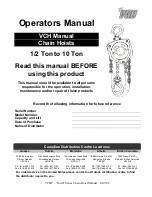
8
USER MANUAL
▪
Red Rooster Lifting Limited
▪
Nauta House, The Meadows, Oldmeldrum, Aberdeenshire, AB51 0EZ
▪
Tel: +44 (0) 1651 872101
▪
M01-AH8 REV0
GETTING STARTED - INSTALLATION & TECHNICAL CHARACTERISTICS
1.4
HOIST ASSEMBLY
Normally our hoist or hoist and trolleys will arrive complete ready to be fitted into position, but sometimes for transportation it may be
necessary to disconnect the chain collector, trolley or the pendant control system.
▪
Chain collectors will be supplied with the necessary bolts and fittings to assemble on site along with any safety slings as shown in
section 1.8 and chain collectors in section 7.4.
▪
Due to the size of some trolleys it is easier to ship split from the hoist, the trolley GA drawings show the load bar and top eye details
for refitting and the control and supply air lines are numbered or colour coded for re-connection.
▪
Where long controls are fitted to a hoist they are colour coded for re-connection on site.
▪
When lifting into position either use the lifting points on the hoist or hoist and trolley, if the hoist does not have lifting points fitted
securely fit slings to the body of the hoist or use the top hook if possible. Do not lift by the controls, valves, or the air set.
MOUNTING THE HOIST
The air hoist is designed as a LIFTING MACHINE and as such is designed exclusively for the lifting loads vertically. Non vertical lifting will
result in premature wear of the chain and chain guide and may result in damage to the limit arms or a failure of the limit arms to operate.
▪
Site the hoist immediately above the load which is to be lifted.
▪
Ensure that the point from which the hoist is suspended has been designed and tested to at least the same safe working load as
the hoist itself.
▪
Ensure that the suspension point or shackle fits snugly into the bowl of the hoist top hook and that the safety catch closes to
prevent escape.
▪
Use only certified lifting gear with a SWL in excess of the load to be lifted to connect to the load itself.
▪
Ensure that the lifting gear fits snugly into the bowl of the hoist bottom hook and that the safety catch closes to prevent escape.
▪
Ensure that the control length (pendant or cords) is adequate to allow the operator to stand away from the load, in a safe and
secure position with the cords or pendant at waist height.
CLOSE HEADROOM WORKING
The lower hook of the TCR / TNC hoist includes a swivel arrangement. This allows the load to turn without twisting the chain. However, when
repeatedly handling loads with the bottom hook close to the hoist, especially when rotation of the load is prevented, there is tendency for the
chain to attempt to enter the guide at an angle. This is particularly pronounced on two fall units. If this problem is noticed when doing a trial lift,
a high quality ball bearing swivel should be mounted below the bottom hook of the hoist.
CHAIN COLLECTORS
If the hoist has been supplied with a chain collector bag or bucket, and the chain has been stored within it during shipment, remove all the
chain from the collector by hand, and remove any knots or twists.
In all cases carefully feed the chain over the load wheel allowing it to fill the collector without any interference as it emerges from the wheel.
This way the collector will fill normally. If the chain within the collector is disturbed great care must be taken the next time that the chain is fed
out of the collector to ensure that it is not twisted or knotted. Chain bags and buckets are fitted with one or two brackets depending on the
model and HOL of the hoist.
See additional instructions (Section 6) for large collectors.
1.5
TECHNICAL CHARACTERISTICS
The WLL of the hoist will be marked on the hoist name plate and also in the hoist specification supplied.
The reactions on the powered hoist on the support, runway beam or crane should have been taken into account in the design of the structure.
The structure should be at least 25% stronger than when using manual equipment due to the shock loading applied by the operational speeds
and the starting and stopping of the hoist.
All Red Rooster hoists are fitted with the following safety features
▪
Upper and lower mechanically operated travel limits. These are ultimate stops and should not be used to stop the hoist on a regular
basis.
▪
Load limiting valve. After assembly and proof test the load limiting valve set is set to stop the operation of the hoist if an overload is
detected. The hoist will stop lifting but will still lower the load.
▪
The disc brake is spring applied so when the controls are not operated or in the event of loss of air supply the brake is applied
holding the load in position.
▪
On pendant controlled hoists an emergency stop button is fitted which connects to a normally open valve either located in the hoist
valve chamber or connected to the hoist. When the emergency stop button is pushed or if the air supply to the hoist is cut off then
the valve will close stopping the hoist.
▪
Red Rooster hoists have a 5:1 factor of safety.
DANGER
DANGER
Summary of Contents for TCR-6000/2
Page 1: ...AIR HOIST USER MANUAL MODEL TCR 6000 2 ...
Page 2: ......



































